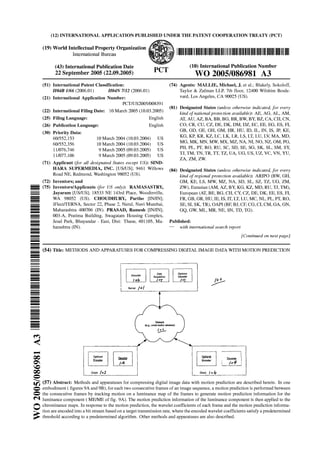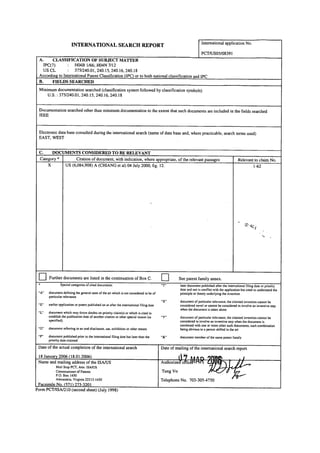1 of 3
Download to read offline



Ad
Recommended
UMAandFemtocells-MakingFMCHappen
UMAandFemtocells-MakingFMCHappenPartho Choudhury
╠²
This document discusses two technologies for fixed-to-mobile convergence: Unlicensed Mobile Access (UMA) and femtocells. UMA allows seamless handover between cellular and WiFi networks using dual-mode phones and a UMA network controller. Femtocells extend cellular coverage indoors using small base stations connected to the core network via broadband. Both aim to improve indoor coverage but take different approaches - UMA leverages existing WiFi networks while femtocells use small cellular base stations. The document compares their benefits and challenges for improving quality of service and enabling new business models for mobile operators.Water quiz voortgezet onderwijs_stichting c3
Water quiz voortgezet onderwijs_stichting c3StichtingC3
╠²
voortgezet onderwijs: waterquiz voor jongerenUS20090263030
US20090263030Partho Choudhury
╠²
The document discloses methods and apparatuses for compressing digital image data. It involves performing a wavelet transform on pixels to generate coefficients, encoding the coefficients into a bitstream based on significance, and transmitting the encoded coefficients. The encoding uses context modeling to determine the probability of a bit based on neighboring bits. The disclosed techniques aim to compress image data for efficient transmission over wired and wireless networks.DVB-SH Link Budget Analysis
DVB-SH Link Budget AnalysisPartho Choudhury
╠²
This document provides an overview and assumptions for analyzing the downlink budget of a DVB-SH system, including the satellite component and complementary ground component. It describes the system architecture, with a satellite transmitting signals to a gap filler base station, which then relays the signals to user equipment. It outlines the calculations and assumptions used to estimate path losses over the satellite link, such as free space loss, precipitation attenuation, and ionospheric scintillation. It also covers factors like the satellite and receiver antenna gains, system temperatures, and the satellite transponder back off level. The overall goal is to provide a rough estimate of the downlink budget for the satellite and terrestrial links in the DVB-SH system.Satellite Downlink Budget Analysis
Satellite Downlink Budget AnalysisPartho Choudhury
╠²
This document discusses various factors involved in analyzing satellite link budgets for S band downlinks. It covers topics like orbital mechanics, path losses, noise temperatures, fading, precipitation effects, choice of modulation schemes, and the differences between using time-division multiplexing (TDM) versus orthogonal frequency-division multiplexing (OFDM) for satellite communications. The document provides assumptions and equations for calculating effective isotropic radiated power, back off levels, antenna figure of merit, free space loss, and other link budget parameters.Final version - MIT FT Capstone 405 SR - MPower
Final version - MIT FT Capstone 405 SR - MPowerPartho Choudhury
╠²
MPower is a proposed intelligent hybrid wallet and micro-blockchain platform that aims to drive financial inclusion in India. It would take advantage of the opportunity to develop new technology-based solutions to address the financial exclusion experienced by many Indians, like Nikki, a single mother struggling with little savings and access to funds. MPower would provide services like P2P payments between family and friends, government payments, and purchases through a hybrid wallet and permissioned local blockchains integrated with identity systems like Aadhaar, while working with the government and banks in a collaborative partnership.US20050207495
US20050207495Partho Choudhury
╠²
This document describes methods and apparatuses for compressing digital image data using motion prediction. It involves performing motion prediction between consecutive frames by tracking motion on luminance maps and applying the motion prediction to chrominance maps. The wavelet coefficients and motion prediction information are then encoded into a bitstream based on a target transmission rate. The encoding satisfies a predetermined threshold according to a predetermined algorithm. The document provides details on various encoding and decoding steps, including wavelet transforms, context modeling, quantization, and motion estimation/compensation.US7522774
US7522774Partho Choudhury
╠²
The document discusses methods and apparatuses for compressing digital image data. It describes performing a wavelet transform on each pixel to generate coefficients, encoding the coefficients into a bit stream based on a target rate, and iteratively encoding coefficients of sub-bands based on a threshold. The encoded data can then be transmitted and decoded. The methods allow for efficient compression of image data for transmission over networks.Technical Report on the DVB-H and DVB-SH
Technical Report on the DVB-H and DVB-SHPartho Choudhury
╠²
The document provides an overview of the DVB-H and DVB-SH standards for digital video broadcasting to mobile devices. It describes the key aspects of the system architecture, including the use of OFDM modulation, time slicing, and MPE-FEC error correction in DVB-H. It also explains how DVB-SH extends coverage to non-urban areas using a satellite component along with a complementary ground component. The motivations for developing these standards to support mobile and perpetually mobile devices are also discussed.The Digital Video Broadcast (DVB) Project
The Digital Video Broadcast (DVB) ProjectPartho Choudhury
╠²
The document provides an overview of the Digital Video Broadcast (DVB) Project. It discusses the DVB Forum and its timeline of standards development. Key DVB standards include DVB-S, DVB-C, DVB-T, DVB-H, and DVB-SH. The document compares DVB standards to competing standards and outlines the system architecture and protocol stack. It also notes that Huawei Satellite Communications (HSC) is exploring opportunities to leverage and integrate with various DVB standards.Wireless_Video_Access_Networks_ppt
Wireless_Video_Access_Networks_pptPartho Choudhury
╠²
The document provides an overview of personal area networks (PANs) that operate over short ranges using wireless technologies. It discusses various wireless standards for PANs including WirelessHD, Ultra Wide Band, TransferJet, Bluetooth, and ZigBee. It describes characteristics like communication ranges of less than 1 foot for close proximity networks and restricted directional antennas for short range. Application areas mentioned include wireless video, audio, and interactive multimedia. Network topologies, regulations, and example use cases for technologies like high-definition television are also summarized.Ultra_Wide_Band_ppt
Ultra_Wide_Band_pptPartho Choudhury
╠²
Ultra-Wideband (UWB) technology uses short-range, low-power wireless transmission over a large bandwidth. It has applications in wireless personal area networks with a range of about 10 meters. UWB uses either very low power transmission over a very large bandwidth or very high power transmission over narrower bands. Multiple standards have been developed for different application scenarios, and UWB can operate in both licensed and unlicensed spectrum.More Related Content
More from Partho Choudhury (7)
Final version - MIT FT Capstone 405 SR - MPower
Final version - MIT FT Capstone 405 SR - MPowerPartho Choudhury
╠²
MPower is a proposed intelligent hybrid wallet and micro-blockchain platform that aims to drive financial inclusion in India. It would take advantage of the opportunity to develop new technology-based solutions to address the financial exclusion experienced by many Indians, like Nikki, a single mother struggling with little savings and access to funds. MPower would provide services like P2P payments between family and friends, government payments, and purchases through a hybrid wallet and permissioned local blockchains integrated with identity systems like Aadhaar, while working with the government and banks in a collaborative partnership.US20050207495
US20050207495Partho Choudhury
╠²
This document describes methods and apparatuses for compressing digital image data using motion prediction. It involves performing motion prediction between consecutive frames by tracking motion on luminance maps and applying the motion prediction to chrominance maps. The wavelet coefficients and motion prediction information are then encoded into a bitstream based on a target transmission rate. The encoding satisfies a predetermined threshold according to a predetermined algorithm. The document provides details on various encoding and decoding steps, including wavelet transforms, context modeling, quantization, and motion estimation/compensation.US7522774
US7522774Partho Choudhury
╠²
The document discusses methods and apparatuses for compressing digital image data. It describes performing a wavelet transform on each pixel to generate coefficients, encoding the coefficients into a bit stream based on a target rate, and iteratively encoding coefficients of sub-bands based on a threshold. The encoded data can then be transmitted and decoded. The methods allow for efficient compression of image data for transmission over networks.Technical Report on the DVB-H and DVB-SH
Technical Report on the DVB-H and DVB-SHPartho Choudhury
╠²
The document provides an overview of the DVB-H and DVB-SH standards for digital video broadcasting to mobile devices. It describes the key aspects of the system architecture, including the use of OFDM modulation, time slicing, and MPE-FEC error correction in DVB-H. It also explains how DVB-SH extends coverage to non-urban areas using a satellite component along with a complementary ground component. The motivations for developing these standards to support mobile and perpetually mobile devices are also discussed.The Digital Video Broadcast (DVB) Project
The Digital Video Broadcast (DVB) ProjectPartho Choudhury
╠²
The document provides an overview of the Digital Video Broadcast (DVB) Project. It discusses the DVB Forum and its timeline of standards development. Key DVB standards include DVB-S, DVB-C, DVB-T, DVB-H, and DVB-SH. The document compares DVB standards to competing standards and outlines the system architecture and protocol stack. It also notes that Huawei Satellite Communications (HSC) is exploring opportunities to leverage and integrate with various DVB standards.Wireless_Video_Access_Networks_ppt
Wireless_Video_Access_Networks_pptPartho Choudhury
╠²
The document provides an overview of personal area networks (PANs) that operate over short ranges using wireless technologies. It discusses various wireless standards for PANs including WirelessHD, Ultra Wide Band, TransferJet, Bluetooth, and ZigBee. It describes characteristics like communication ranges of less than 1 foot for close proximity networks and restricted directional antennas for short range. Application areas mentioned include wireless video, audio, and interactive multimedia. Network topologies, regulations, and example use cases for technologies like high-definition television are also summarized.Ultra_Wide_Band_ppt
Ultra_Wide_Band_pptPartho Choudhury
╠²
Ultra-Wideband (UWB) technology uses short-range, low-power wireless transmission over a large bandwidth. It has applications in wireless personal area networks with a range of about 10 meters. UWB uses either very low power transmission over a very large bandwidth or very high power transmission over narrower bands. Multiple standards have been developed for different application scenarios, and UWB can operate in both licensed and unlicensed spectrum.